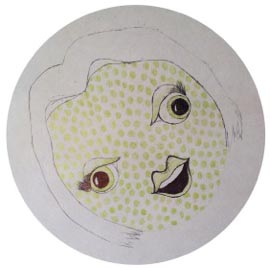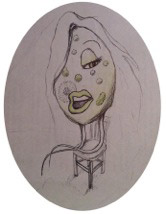A green-algal love story: in words and art
By Jeremy Lant
(*With mentorship from Sara Asmail and David Smith).
“Write a science essay about these algae,” said Sara Asmail, a Masters student from the Smith lab in Western University’s Biology Department, where I am undergraduate research volunteer. It was easy to understand why Sara wanted me to write about algae: they are beautiful, bewilderingly diverse and complex, and help sustain life on Earth. But not everyone is as stoked on algae as Sara and me. And some, believe it or not, actually think that these microbial pond lovers are boring. So I accepted Sara’s challenge and wrote a story, with illustrations, about how I was introduced to the realm of miniature photosynthesizers, and how one alga in particular recently stole my heart.
What are algae? The dull answer is chloroplast-containing organisms that do not have roots, shoots, or leaves. The sexy answer is that algae are marvelous, multifarious, sun-loving species. They can be found in almost any ecosystem on earth—from the hottest deserts to the Antarctic to alpine glaciers. They can be giants, forming endless forests on the sea floor or tiny unicells invisible to the naked eye. They can be flat and skinny like a kite, fat and round like a globe, or bent like a boomerang. They can be peacefully pumping out the oxygen that feeds our lungs and planet or maliciously replicating in our blood as deadly parasites. They can be Casanovas, partaking in complex mating rituals and acts of cooperation or highly efficient solo artists. They can be seen from outer space, forming blooms that stretch for hundreds of kilometers. They can be green, red, pink, fluorescent yellow, or colorless. They can be cool, hot, or frozen solid. They are anything but ordinary and not the least bit boring.
My first algal love affair began in high school science class and involved an oversized sphere called Volvox (known as “the fierce roller”). Although young and naïve when it came to algae, I was excited when the teacher announced that he was going to show us a live sample of Volvox. “Today, ladies and gentlemen,” he said, “you will be introduced to a photosynthetic masterpiece.” The teacher then pulled out a large flask containing light green fluid and asked the class to take a sample and prepare a microscope slide. After struggling to get the slide in focus, I began to lose patience. So I left the field of vision in place, and just stared, pretending I knew what I was doing. As I sat there, feigning competence, a wonderful thing happened: from the edge of my field of view, it came tumbling in … the fierce roller. It was love at first sight.

Volvox
Chlamydomonas (called Chlamy for short) is the diva of the algal domain. It’s a microbial superstar and the most highly studied alga in the world, being used as a model for investigating everything from photosynthesis to flagellar motion to the origin of plants. It was my enthusiastic first-year biology professor, Denis Maxwell, an algal connoisseur and Chlamydomonas researcher extraordinaire, who first introduced me to Chlamy. In a lecture strewn with excitement and hyperbole, Dr. Maxwell projected the spectacular Chlamy on a giant screen and proceeded to list all of the wondrous features of this puny alga, which punches above its weight in any and all freshwater arenas. “It even has an eye,” screamed Denis, “which guides it towards the light. And look at those two lovely flagella, my goodness! Those babies propel it to the sweet spot—not too bright, not too dark, that’s the way Chlamy likes it.”

Chlamydomonas
All I could think during that lecture was, “Chill out, Dr. Maxwell. It’s just an alga.” So I went back to my residence room and did some online reading to figure out what could possibly make my professor so excited. I found that Dr. Maxwell’s enthusiasm was more than justified: not only does Chlamy have a wide range of basic research applications and a completely sequenced genome, but it also has many practical uses, including biofuel production and bioremediation. Impressive, but Chlamydomonas was too flashy for my tastes. The high-impact papers and competitive research environment turned me off—I wanted to find a genus that was more mysterious. So I dropped the diva and went for its sister—the sister lineage of Chlamydomonas, to be precise, which is called Polytomella.
In many ways, Chlamy and Polytomella are alike: both are single-celled swimmers that thrive in fresh water and have multiple flagella (although Polytomella has four, which is two more than Chlamy). There is, however, one really big difference between them: Polytomella lacks chlorophyll and consequently is not green and cannot derive energy from sunlight—it’s an evolutionary burnout. When I first saw a high-definition image of Polytomella, I was disappointed because it lacked the lovely green shades found in Volvox and Chlamy. But as I learned more about this photosynthetic dud, I realized it has other endearing traits, such as really weird genomes, which make up for its lackluster colour.

Polytomella
Plants and algae contain three different types of genome: a nuclear genome, which is big and stored in the head office of the cell (the nucleus), a mitochondrial genome, which is generally small and found in the power house of the cell (the mitochondrion), and a chloroplast genome, which is medium sized and—you guessed it—housed in the chloroplast, where photosynthesis takes place. Never has there been a concrete example of a plant or alga that doesn’t have all three of these genomes, that is, until Polytomella came along.
A recent study led by the Smith lab at Western University, which is gaining a lot of press, showed that Polytomella has discarded its chloroplast genome. Crazy, eh? Let me try to explain how this happened. Polytomella descends from a photosynthetic ancestor, but at some point in the distant past it lost the ability to perform photosynthesis—probably from a deleterious mutation—and therefore survives by absorbing small, energy-rich molecules from its environment as opposed to converting sunlight into sugar. Since losing photosynthesis, Polytomella’s photosynthetic organelle, the chloroplast, has been “put out to pasture.” It’s lost all of the brightly colored chlorophylls, complex inner-membrane structures, and light-harvesting infrastructure found in photosynthetic chloroplasts. Thus, it is not surprising that the genome within the Polytomella chloroplast has also withered away. That said, the Polytomella chloroplast still performs some crucial functions apart from photosynthesis, like synthesizing fats. Other non-photosynthetic plants and algae have also lost large sections of their chloroplast genome, but Polytomella is the first organism to have taken this process to the ultimate extreme—genome loss. Eventually, Polytomella may lose its chloroplast outright, but for this to happen, it will have to find a way to outsource remaining chloroplast functions (like fatty acid biosynthesis) to other organelles in the cell.
It may seem puzzling that after millions of years of evolving and refining the photosynthetic process, Polytomella has reverted back to eating in the dark. But this is why I love Polytomella: it’s doing its own thing and doesn’t care what other algae think. It doesn’t even feel the need to conform to the title ‘green alga’ by actually being green.
So that’s how I got hooked on algae—from my first experience with the stunning Volvox, to a short-lived affair with the high-flying Chlamy, and to a lasting love for the eccentric Polytomella. I hope that I piqued your interest in green algae, and sold you on Polytomella, which has been hiding in the shadow of Chlamydomonas for too long. Not that Polytomella would care—it doesn’t crave the limelight or the sunlight.
*Jeremy Lant (@J_Lant) is a third-year undergraduate student studying Biology at Western University, and is a volunteer science writer in David Smith’s lab (@arrogantgenome), biology dept. Sara Asmail is an MSc candidate in Biology at Western.
All of the images in this article were hand drawn by Jeremy, at a lab bench, of course.

